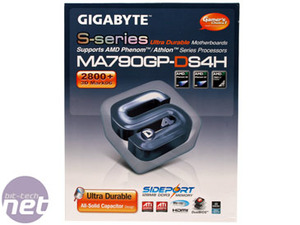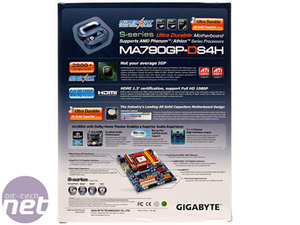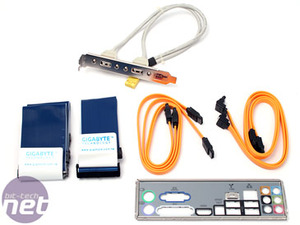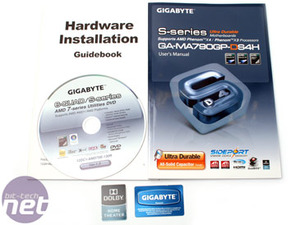Manufacturer: Gigabyte
UK Price (as Reviewed): £105.99 (RRP)
US Price (as Reviewed): $139.99
We covered the basics of the 790GX chipset in our launch article earlier this month - that details the new features in the northbridge and SB750 southbridge, as well as our overclocking exploits.
Gigabyte was (as usual) the first to contact us with its retail 790GX board, the GA-MA790GP-DS4H, and we were only too happy to get it in for a burn through. We even got a GA-MA78G-DS3H chucked in, based on the slightly older but very similar 780G chipset, and this board also supports CrossFire meaning we could now test top to bottom gaming performance between platforms: integrated graphics, Hybrid CrossFire, single card PCI-Express graphics and CrossFireX.
The only problem was the GA-MA78G-DS3H only supports 95W AMD CPUs, while the GA-MA790GP-DS4H will take up to the full 125W. With that in mind this limits our Apples to Apples comparison because we can't drop a Phenom X4 9850 Black Edition into the 780G board. After much deliberation, we decided to review platform versus platform - the more expensive, "enthusiast" 790GX + SB750 with the full-fat Phenom X4 9850 BE, versus the 780G + SB700 and semi-skimmed Phenom X3 8750.
In addition to these we've also got the Asus M3A32-MVP Deluxe, another "enthusiast" board built around the 790FX chipset and older SB600 southbridge. We've checked the key performance differences across the range of southbridges too - USB and SATA - with some interesting results.
Finally we've also thrown in a bit of the competition too - the Asus CrossHair II. It's another enthusiast board built around the Nvidia nForce 780a chipset that naturally features SLI instead of CrossFire, but is also priced above the AMD 790GX - does the extra cost warrant the difference in performance? After all, the nForce 780a is built around the same graphics core as the GeForce 8200 IGP (we reviewed it here), so the performance should be the same - the only difference is the nForce 780a comes with the NF200 chip bolted on to provide a pair of full PCI-Express 2.0 x16 lanes.
So which platform is best for the cost or which simply performs better? Let's find out.
The box is a bit short on USB connectors (since the board offers eight via pin-outs) and there is no extra Firewire bracket or eSATA option Gigabyte usually throws in, even though the new southbridge has ACHI in the BIOS, just like Nvidia and Intel southbridges.
Gigabyte does include its clip-locking SATA connectors and even a couple of 90 degree connectors to keep things varied.
UK Price (as Reviewed): £105.99 (RRP)
US Price (as Reviewed): $139.99
Introduction
Integrated graphics, Hybrid CrossFire, CrossFireX - it's confusing to say the least. With so much choice in the latest AMD (and Nvidia) chipsets we wonder if anyone actually really gets it all.We covered the basics of the 790GX chipset in our launch article earlier this month - that details the new features in the northbridge and SB750 southbridge, as well as our overclocking exploits.
Gigabyte was (as usual) the first to contact us with its retail 790GX board, the GA-MA790GP-DS4H, and we were only too happy to get it in for a burn through. We even got a GA-MA78G-DS3H chucked in, based on the slightly older but very similar 780G chipset, and this board also supports CrossFire meaning we could now test top to bottom gaming performance between platforms: integrated graphics, Hybrid CrossFire, single card PCI-Express graphics and CrossFireX.
The only problem was the GA-MA78G-DS3H only supports 95W AMD CPUs, while the GA-MA790GP-DS4H will take up to the full 125W. With that in mind this limits our Apples to Apples comparison because we can't drop a Phenom X4 9850 Black Edition into the 780G board. After much deliberation, we decided to review platform versus platform - the more expensive, "enthusiast" 790GX + SB750 with the full-fat Phenom X4 9850 BE, versus the 780G + SB700 and semi-skimmed Phenom X3 8750.
In addition to these we've also got the Asus M3A32-MVP Deluxe, another "enthusiast" board built around the 790FX chipset and older SB600 southbridge. We've checked the key performance differences across the range of southbridges too - USB and SATA - with some interesting results.
Finally we've also thrown in a bit of the competition too - the Asus CrossHair II. It's another enthusiast board built around the Nvidia nForce 780a chipset that naturally features SLI instead of CrossFire, but is also priced above the AMD 790GX - does the extra cost warrant the difference in performance? After all, the nForce 780a is built around the same graphics core as the GeForce 8200 IGP (we reviewed it here), so the performance should be the same - the only difference is the nForce 780a comes with the NF200 chip bolted on to provide a pair of full PCI-Express 2.0 x16 lanes.
So which platform is best for the cost or which simply performs better? Let's find out.
Gigabyte GA-MA790GP-DS4H Features
- Support for all Athlon and Phenom processors on socket AM2+/ AM2 up to 140W
- North Bridge: AMD 790GX with 128MB DDR3 SidePort memory
- South Bridge: AMD SB750
- Foru 1.8V DDR2 DIMM sockets supporting up to 16 GB of system memory at 667MHz or 800MHz with Athlon CPUs and 1,066MHz with Phenom CPUs
- Realtek ALC889A 7.1 channel High-Definition audio codec with content protection
- Realtek 8111C PCI-Express Gigabit Ethernet
- Two PCI-Express 2.0 x16 slots (either x16 and x1 or x8 and x8) with support for CrossFireX and Hybrid CrossFire
- Three PCI-Express 2.0 x1 slots
- Two PCI slots
- Six SATA 3Gbps ports with support for RAID 0, 1, 0+1, 5 and JBOD
- One IDE connector
- Twelve USB 2.0 ports - four on rear I/O, eight via pin-outs
- Three IEEE1394a Firewire connectors - two via pin-outs and one on rear I/O - from a Texas Instruments TSB43AB23 chipset
The box is a bit short on USB connectors (since the board offers eight via pin-outs) and there is no extra Firewire bracket or eSATA option Gigabyte usually throws in, even though the new southbridge has ACHI in the BIOS, just like Nvidia and Intel southbridges.
Gigabyte does include its clip-locking SATA connectors and even a couple of 90 degree connectors to keep things varied.

MSI MPG Velox 100R Chassis Review
October 14 2021 | 15:04













Want to comment? Please log in.